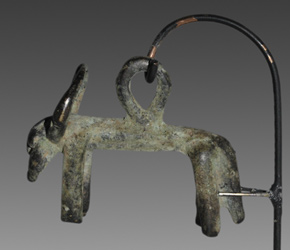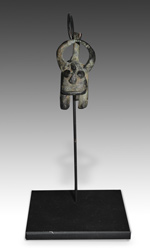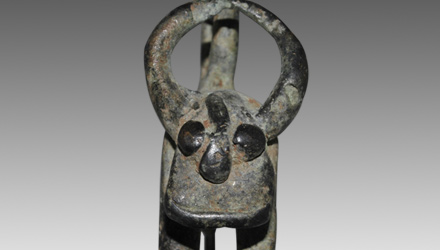 |
|
"The Senufo produce a rich variety of sculptures, mainly associated with the poro society. One type of Senofu yawiige was worn only by members of a secret society within the poro called the nokariga – meaning 'to change into an ox'"
The Senufo people number approximately 1,000,000 to 1,500,000 and live in Côte d'Ivoire, Ghana, Burkina Faso, and the extreme south of Mali in West Africa. They live principally off the fruits of agriculture, although small amounts of hunting and fishing also contribute to the local economy. Senufo crops are typical of the region, including millet, sorghum, maize, rice, yams, and a host of other crops that have been borrowed from cultures throughout the world. Small farm animals such as sheep, goats, chickens, and guinea fowl, are also raised. While the Senufo may be described as people who live off the land; the important point is that in Senufo society, labor is divided between farmers and skilled artisans.
 |
|
In addition to a belief in a creator deity, ancestors and nature spirits, a central concept in Senufo religion is a female ancestral spirit called “ancient mother,” the sacred guiding spirit of an association called the poro society. All adult men belong to the poro society, which maintains the continuity of religious and historical traditions, especially through the cult of the ancestors. The poro is the pillar of communal life. It is responsible for initiation and training of young boys, and is aimed at shaping an accomplished, social man who is integrated into society and assumes public responsibilities. The corresponding woman’s association is called the sandogo. It is in charge of divination, and among other duties is responsible for contact with spirits who might be bothered by the activities of the hunt, farming, or of artisans.
The Senufo produce a rich variety of sculptures, mainly associated with the poro society. The sculptors and metal smiths, the artisan groups responsible for making cult objects live on their own in a separate part of the village. The attitude shown toward them by other Senufo is a mixture of fear and respect, owing to their privileged relationship with the natural forces that they are capable of channeling in a sculpture. The metal smith, in particular, has a special role in Senufo society because of his seemingly magical connection with fire and the special practices of extracting metal from earth. Works in metal are said to contain consecrated earth.
Occasionally, sandogo diviners will prescribe to their clients the acquisition of wearable ornaments created from iron and copper alloys in order to manage difficulties, treat illnesses, and attain goals. Collectively, these objects are known as yawiige, and most often they take the form of amulets, bracelets and rings. Some yawiige are representations of protective spirits known as madebele. These are bush spirits who live in the forest and water surrounding the Senufo territory. Madebele require constant appeasement, which is accomplished by wearing yawiige made in their likeness. In executing these ornaments, the aim of the metal smith is to please the spirits so they will be empowered to intervene in human affairs in a positive way.
One type of yawiige was worn only by members of a secret society within the poro called the nokariga. These ornaments depict a madebele in the form of an ox. The name nokariga means “to change into an ox,” and refers to the extraordinary abilities members of this society were said to possess. In the farming society of the Senufo, hunters were thought to be powerful, sometimes even shady people who left the village at night to hunt dangerous animals in the wilderness. In general, hunters were pushed to the edge of Senufo society, but this kind of social sanction applied even more to members of the nokariga society. It was believed they not only went hunting, but changed themselves into oxen, according to stories they themselves spread. By turning into oxen they could approach the animals unnoticed and then overpower them. This yawiige amulet was undoubtedly worn by a member of the nokariga society as a means of appeasing one particular madebele – the ox – with whom they felt the greatest affinity and were inextricably linked.

|
|